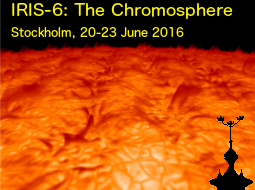Speaker
Shuhong Yang
(NAOC)
Description
With the high tempo-spatial Interface Region Imaging Spectrograph 1330 Å images, we
find that many bright structures are rooted in the light bridge of NOAA 12192,
forming a light wall. The light wall is brighter than the surrounding areas, and the
wall top is much brighter than the wall body. The New Vacuum Solar Telescope Hα and
the Solar Dynamics Observatory 171 and 131 Å images are also used to study the
light-wall properties. In 1330, 171, and 131 Å, the top of the wall has a higher
emission, while in the Hα line, the wall-top emission is very low. The wall body
corresponds to bright areas in 1330 Å and dark areas in the other lines. The top of
the light wall moves upward and downward successively, performing oscillations in
height. The deprojected mean height, amplitude, oscillation velocity, and the
dominant period are determined to be 3.6 Mm, 0.9 Mm, 15.4 km s−1, and 3.9 minutes,
respectively. We interpret the oscillations of the light wall as the leakage of
p-modes from below the photosphere. The constant brightness enhancement of the wall
top implies the existence of some kind of atmospheric heating, e.g., via the
persistent small-scale reconnection or the magneto-acoustic waves. In another series
of 1330 Å images, we find that the wall top in the upward motion phase is
significantly brighter than in the downward phase. This kind of oscillation may be
powered by the energy released due to intermittent impulsive magnetic reconnection.
Author
Shuhong Yang
(NAOC)

